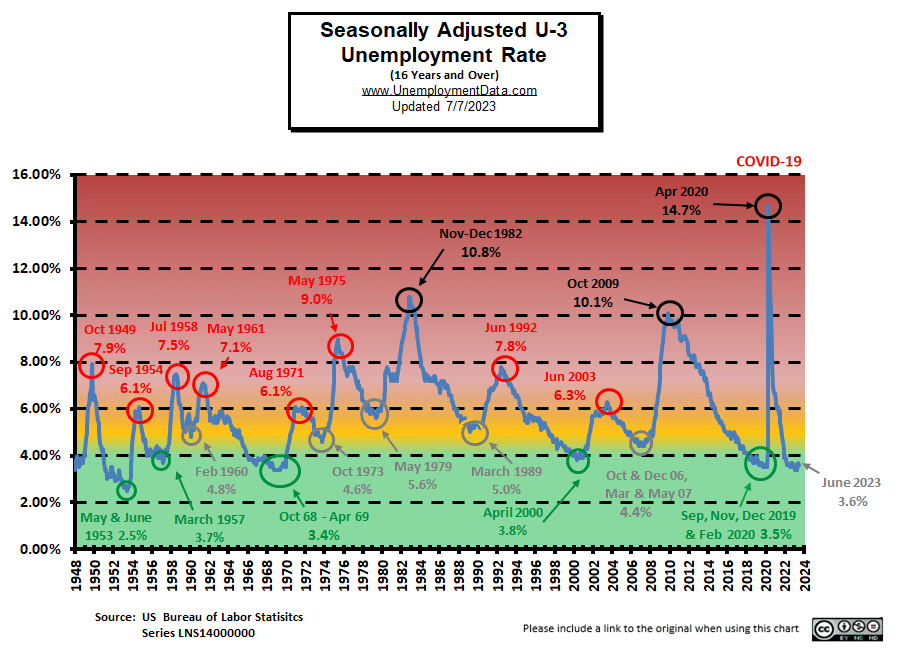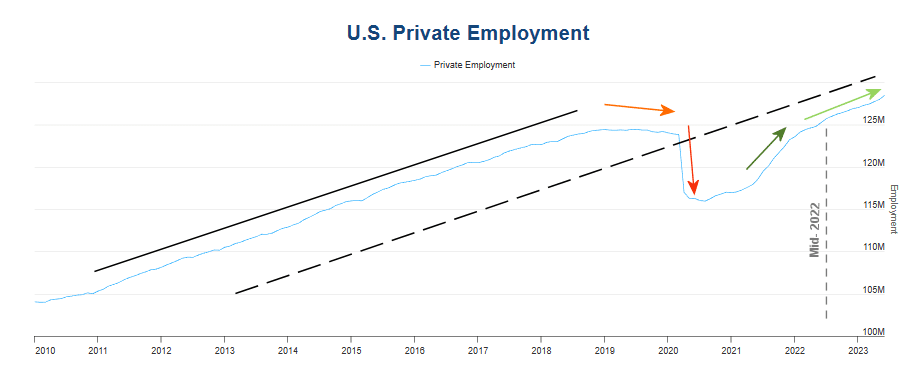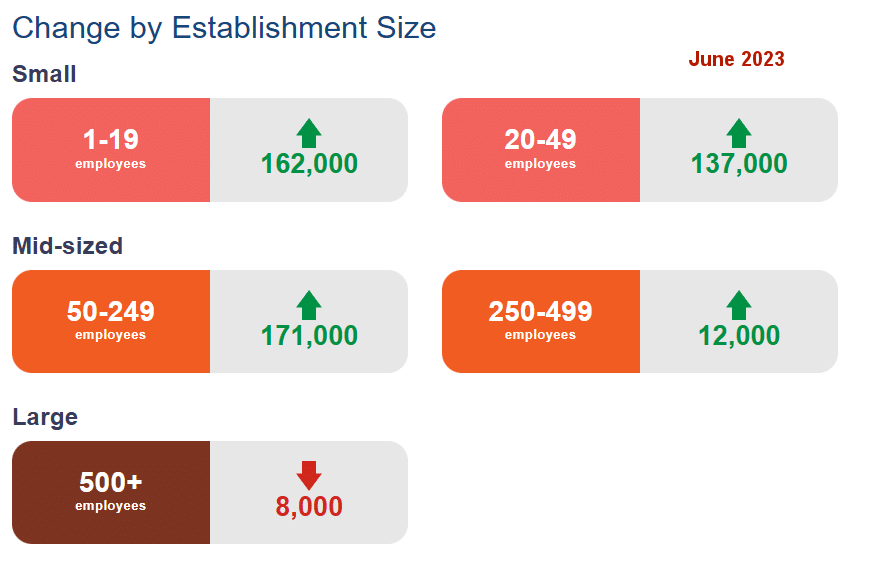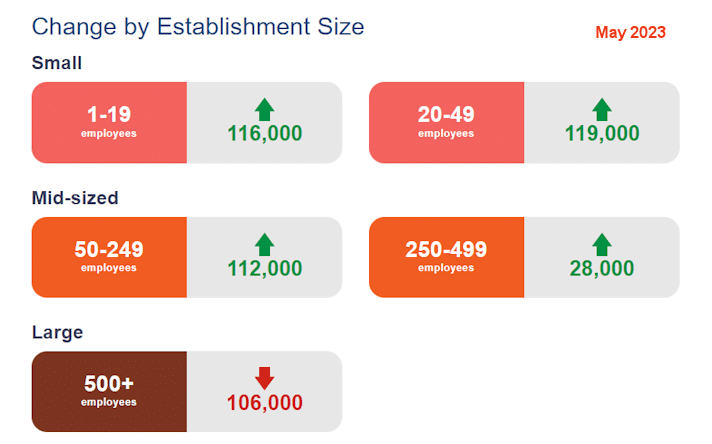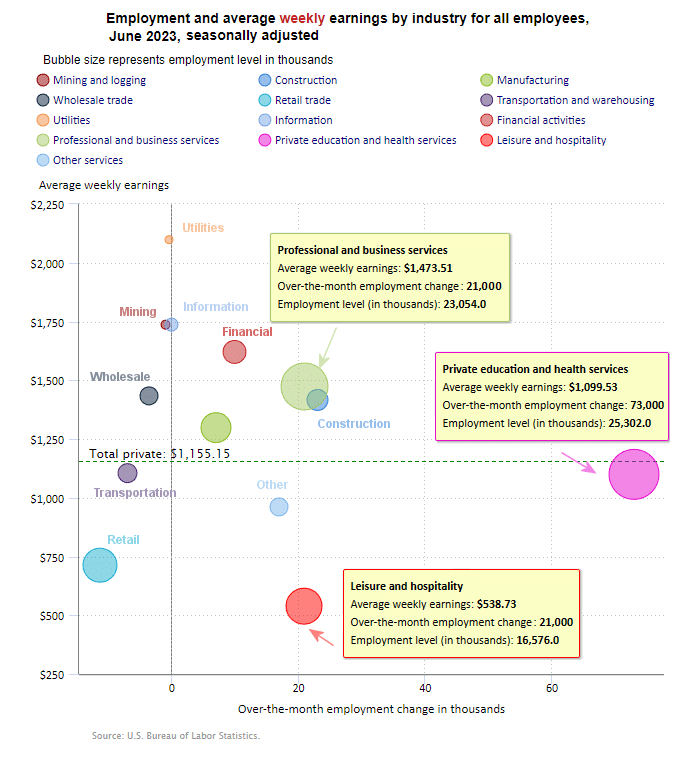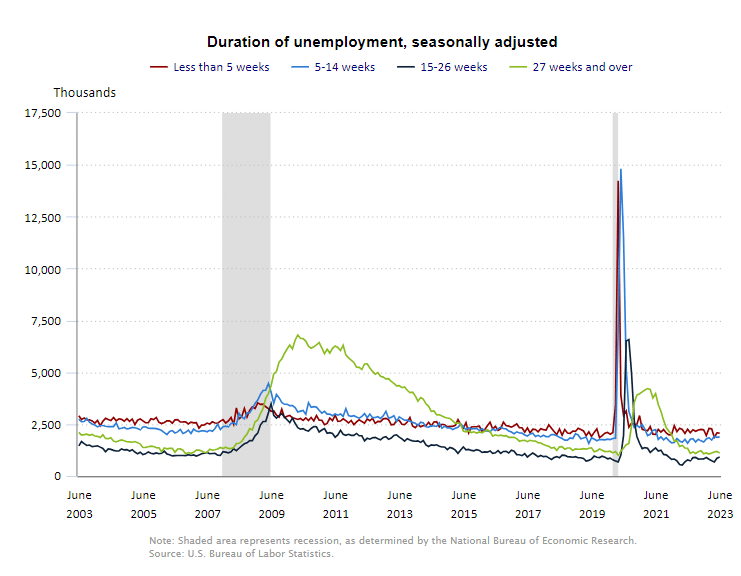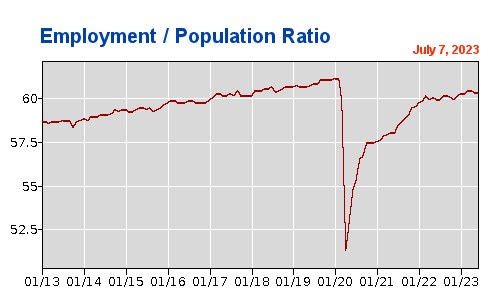The U.S. Bureau of Labor Statistics (BLS) released its employment / unemployment report for June on July 7th 2023.
Adjusted Unemployment down Slightly
- Adjusted U-3 was 3.6% down from 3.7%
- Unadjusted U-3 was 3.8% up from 3.4%
- Unadjusted U-6 was 7.2% Up from 6.4%
- Labor Force Participation unchanged at 62.6%
- Unadjusted Employment rose from 156.266 to 156.963 million
According to the Commissioner of the U.S. Bureau of Labor Statistics:
“Total nonfarm payroll employment increased by 209,000 in June, and the unemployment rate changed little at 3.6 percent, the U.S. Bureau of Labor Statistics reported today. Employment continued to trend up in government, health care, social assistance, and construction… Both the unemployment rate, at 3.6 percent, and the number of unemployed persons, at 6.0 million, changed little in June. The unemployment rate has ranged from 3.4 percent to 3.7 percent since March 2022.”
You can read the full BLS report here.
As usual, they are talking about “Seasonally Adjusted Jobs”.
Looking at the Unadjusted Establishment Survey report we see…
Originally the BLS reported employment of 156.306 million for May which they adjusted to 156.266 million. So, they subtracted 40,000 jobs for May. They are now reporting 156.963 million jobs for June which is actually an increase of 657,000 jobs based on their original estimates or an increase of 697,000 based on their updated numbers.
Current Employment Rate Chart
Adjusted Unemployment is slightly above the pre-COVID 2019 cyclical lows of 3.5%. We’ve been saying that “typically, March or April has one of the lowest unemployment rates for the year, so we could see a slight increase from here without an actual deterioration of the labor market.” And that is precisely what is happening. Current levels are still within the “Green Zone”.
Full Employment?
For several months now we’ve been talking about “full employment”:
“Full Employment is when everyone who wants a job has one. It is generally considered to be slightly above 3%. Although, other factors, such as unemployment benefits, can shift the level higher or lower. So, if unemployment benefits are extended from 6 months to 1 year, people will tend to stay unemployed longer, thus raising the unemployment rate.”
After the unemployment rate almost touched the magic full employment line in April, it has begun moving away (i.e., higher unemployment). If this continues into the fall months, it could be the beginning of a recession. However, as we’ve said, the Summer months tend to have higher unemployment, so this is perfectly normal.
Note: The Unemployment rate is inverted to track the employment rate. Neither is Seasonally Adjusted.
Full employment is not considered to be at zero percent because even when employers are having difficulty finding employees, some people are still unemployed due to either structural unemployment (mismatch between worker skills and job requirements, i.e., not enough training) or simply because they quit their job knowing it would be easy to find another (hopefully better) job. Often referred to as frictional unemployment (there will always be people who have quit or have lost a seasonal job and are in the process of getting a new job). See: Highly Skilled Worker Shortage in a Recession?
If the unemployment rate stays constant, but more people are working, where are these extra workers coming from?
Somehow the workforce has to be growing to accommodate these newly created jobs. They could be long-term unemployed (no longer counted in the workforce) returning to the workforce, they could be immigrants entering the workforce, or possibly retired people coming out of retirement because of an offer too good to turn down. This is generally facilitated by rising wages, but this month’s ADP report indicates that wage growth has slowed, possibly indicating that we are nearing the end of this boom.
Current Employment Rate
Despite the fact that both the unadjusted U-3 and U-6 unemployment rates were up, there were actually almost 700,000 more people working in June than in May. Total Employed was 155.386 million in April, 156.266 million in May, and 156.963 in June.
At 156.963 million, June Employment is above the November 2022 peak employment level of 155.642 million.

ADP® National Employment Report
ADP provides an independent (non-government) estimate of private-sector employment and pay, based on data derived from ADP client payrolls. According to ADP®, In collaboration with Stanford Digital Economy Lab.
ADP: Private employers added 497,000 jobs in June.
- Job creation surged in June, led by consumer-facing services. Leisure and hospitality, trade and transportation, and education and health services showed strong gains. Still, the market was fragmented, with manufacturing, information, and finance showing declines.
Ms. Richardson is saying that although employers are still hiring, upward pressure on salaries is easing.
I’ve added a few lines and arrows to the ADP employment chart. The slope of the solid black line represents the rate of increase in jobs from 2011 through mid-2018. Then the rate of increase dropped off and total employment slightly decreased (orange arrow). The red arrow is the COVID crash in employment. Then the dark green arrow shows the rapid recovery of jobs. By Mid-2022, employment was back at pre-COVID levels. The dotted line has the identical slope as the black line. So, we can see that since mid-2022 employment has been on the exact same trajectory as it was from 2011 to 2018, with perhaps even a slight upturn in June.
ADP Private Employment by Firm Size
ADP also lists increases by “firm size”.
This month, small and mid-size companies added employees, while Large companies downsized a slight bit.
June ADP Changes:
May ADP Changes:
If we compare May to June, we can see that in May, large companies cut staffing by 106,000 while in June staffing cuts were much smaller. Also Gains in the other size companies were much larger in June than in May.
ADP Job Gainers
As you would expect for Summer, the biggest gainer was Leisure and Hospitality, followed by construction.
ADP Job Losers
As far as the industry sectors are concerned, in April there were only three sectors that lost employees, May had five, June had four. The biggest loser in June was Manufacturing.
ADP Also Tracks Salary Changes:
As you would expect in a tight labor market, “Job Changers” saw a much greater increase in salary than those who stayed in their job, as companies needed to offer significant increases in order to attract new employees, but the benefit of changing jobs continues to decrease.
Source: ADP® Pay Insights
June 2023 Employment by Sector
The employment “bubble chart” is a quick and easy way to see how each sector performs on a seasonally adjusted basis. The Bubble’s Size tells us the total Employment for that industry (i.e., larger bubbles mean more people are employed in that sector).
The bubble’s location on the chart tells us that there has been a change in Employment Levels over the most recent month… A bubble further to the right indicates larger job growth. A bubble’s vertical location on the chart shows the average industry salary.
Remember, these are Seasonally Adjusted Numbers, so they aren’t cumulative!
The biggest gainers according to the BLS were Education and health services, followed by Professional Services, and Leisure and Hospitality. Average weekly wages saw a gain in June.
BLS Average Weekly Wages
| Date | Average Weekly Wage |
| June 2023 | $1,155.15 |
| May 2023 | $1,146.99 |
| April 2023 | $1,147.58 |
| March 2023 | $1,141.34 |
| February 2023 | $1,141.61 |
| January 2023 | $1,146.14 |
| December 2022 | $1,125.73 |
| November 2022 | $1,129.01 |
| October 2022 | $1,124.01 |
| September 2022 | $1,119.87 |
| August 2022 | $1,116.42 |
| July 2022 | $1,116.54 |
| June 2022 | $1,106.76 |
| May 2022 | $1,105.47 |
| April 2022 | $1,102.01 |
| December 2021 | $1,086.46 |
BLS Employment and Average Weekly Earnings by Industry
June 2023, Seasonally Adjusted Employment
We’ve added a column to the table below showing the employment levels the BLS reported the previous month. Note that due to “seasonal adjusting,” although they may claim that there was a “monthly increase” (or decrease), there isn’t always an actual increase; you can’t just subtract last month’s “employment level” from this month’s level. For instance, Manufacturing was supposed to have 12,984,000 employees in May and have a 7,000 “increase”, but in June, there were 12,989,000 employed. That looks like a 5,000 increase to me. And Transportation went from 6,763,000 in May to 6,730,000 in June for a seasonally adjusted -6,900 decrease, but it seems like an -33,000 decrease to me. And Information appears to have gained 11,000 but on a seasonally adjusted basis it is reported as zero.
| Industry | June Monthly Increase | June Ave. Weekly Earnings | June Employment Level | May Employment Level |
| Total Private Employment | 149,000 | $1,155.15 | 133,494,000 | 133,443,000 |
| Mining and Logging | -1,000 | $1,736.45 | 642,000 | 643,000 |
| Construction | 23,000 | $1,416.09 | 7,947,000 | 7,928,000 |
| Manufacturing | 7,000 | $1,298.44 | 12,989,000 | 12,984,000 |
| Wholesale trade | -3,600 | $1,433.47 | 6,047,000 | 6,051,400 |
| Retail trade | -11,200 | $713.12 | 15,539,000 | 15,550,800 |
| Transportation and Warehousing | -6,900 | $1,104.66 | 6,730,000 | 6,763,000 |
| Utilities | -300 | $2,098.08 | 556,600 | 555,900 |
| Information | 0 | $1,736.59 | 3,095,000 | 3,084,000 |
| Financial Activities | 10,000 | $1,620.54 | 9,144,000 | 9,130,000 |
| Professional and Business Services | 21,000 | $1,473.51 | 23,054,000 | 23,053,000 |
| Private Education and Health Services | 73,000 | $1,099.53 | 25,302,000 | 25,254,000 |
| Leisure and Hospitality | 21,000 | $538.73 | 16,576,000 | 16,596,000 |
| Other Services | 17,000 | $960.93 | 5,872,000 | 5,850,000 |
Source: BLS
Note: As usual, ADP has an entirely different picture. See Above.
Unemployment
June’s Seasonally Adjusted Unemployment is 3.6%, down from 3.7% in May.

June 2023 Labor Force Participation Rate
The LFPR is unchanged again at 62.6%.

Seasonally Adjusted U1 through U6 Unemployment Rates
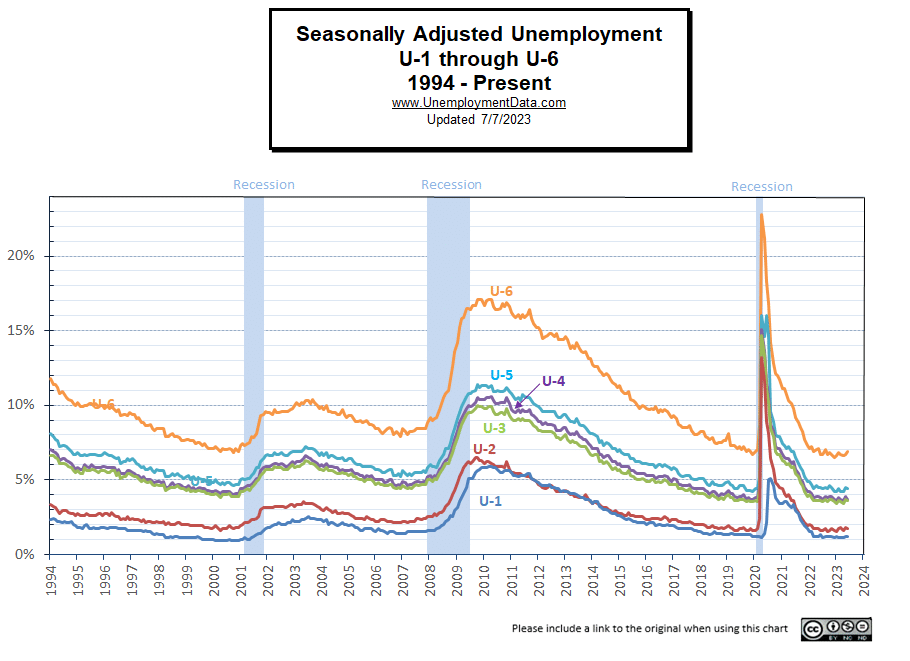
Seasonally Adjusted Unemployment by Education
For the third month in a row unemployment by the uneducated rose significantly, which could signal the beginning of a tightening labor market.
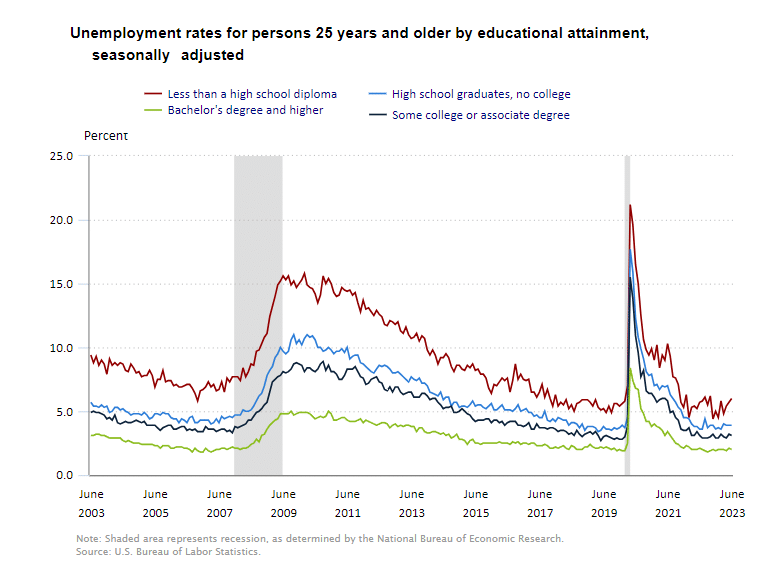
Duration of Unemployment
Long-term unemployment (over 27 weeks) remains low, but 15-26 week unemployment continues to tick up.
Employment-Population Ratio
The Employment / Population ratio fell from April’s 60.4% of the population employed to 60.3% in May and June.
See Employment Population Ratio for more information
Read more on UnemploymentData.com.
- What to Do When Your A/C Gives Out at Work
- Construction Consultants: What Are They and How to Work With Them
- Yet Another Month of Questionable Federal Jobs Data as 310,000 Fewer People Report Having Jobs
From InflationData.com
- Radical Decentralization: the Key to Wealth and Freedom
- The Effects of Raising the Debt Ceiling
- May Inflation Falls to 4%
- Default by Inflation
- Is There an Optimum Growth Rate of Money?
From Financial Trend Forecaster
- Moore Inflation Predictor
- NYSE ROC
- NASDAQ ROC
- There is No Such Thing as a “Natural” Monopoly
- The Eurozone Falls into Recession as “Stimulus” Fails
- Is it Really Paranoid to Worry about a Central Bank Digital Currency?
- Commercial Banks Suffer Along With Commercial Real Estate
- Stocks and Junk Bonds: “This Divergence Appears Meaningful”
- Market Outlook May 31, 2023
- Where is the Market Headed in May 2023
- Is a Pension Fund Crisis Next?
- Corporate Bonds: “The Next Shoe to Drop”?
From OptioMoney.com
- Smart Ways to Save Money on Everyday Expenses
- Simple Ways to Improve Your Relationship with Money
- Smart Ways to Avoid Financial FOMO
- How Buying a House Affects Your Finances
- Top Personal Finance Apps of 2023
From Your Family Finances

